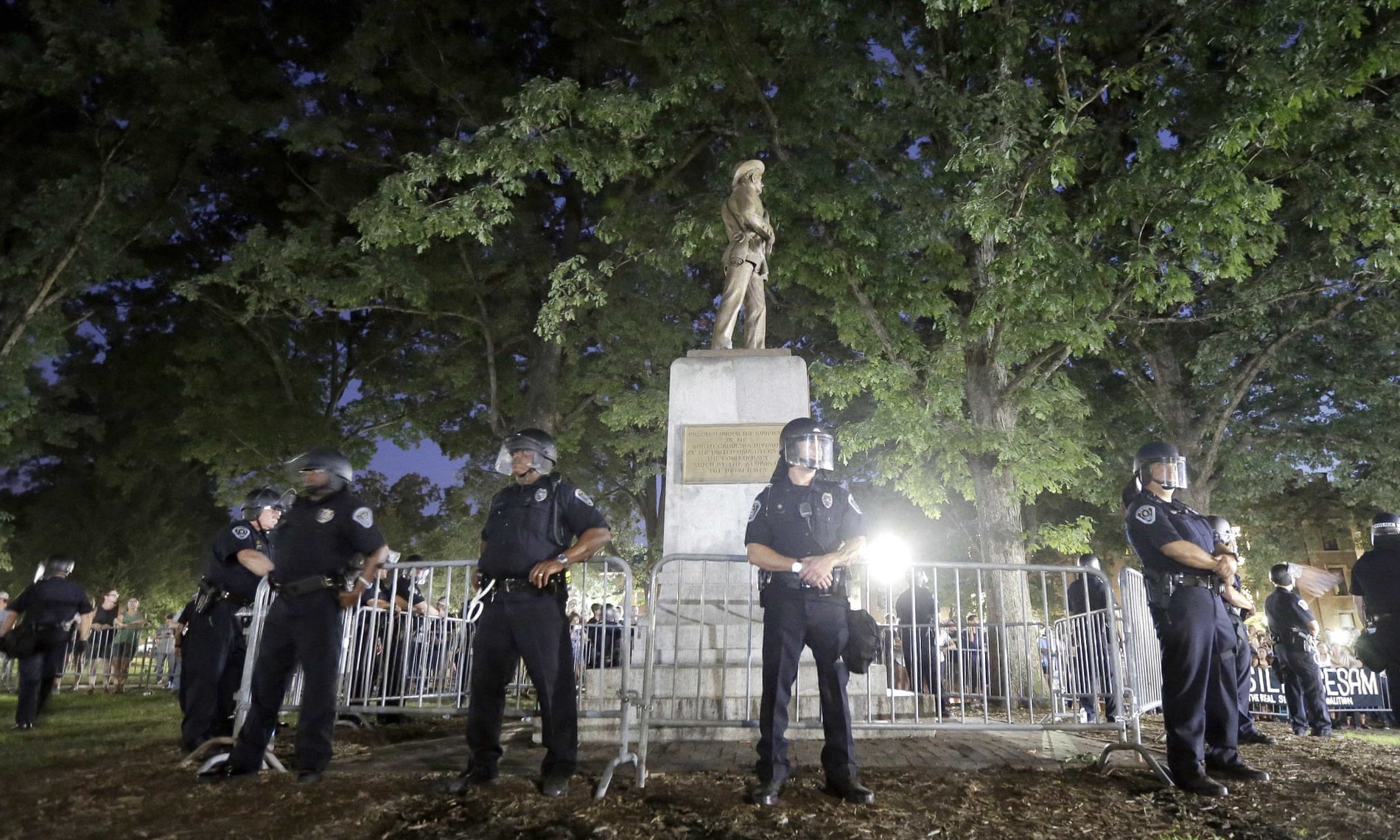Cape Town was the first. In March 2015, a student named Chumani Maxwele brought a bucket filled with shit to the University of Cape Town, where there stood a statue of Cecil Rhodes, the British diamond magnate, colonial politician and avowed white supremacist. “There is no collective history here – where are our heroes and ancestors?” Maxwele announced. He splashed the contents of the bucket over the monument.
The incident attracted national attention and within days had grown into a full-scale protest. Students covered the Rhodes statue with graffiti and plastic bags, and promised to demonstrate until it was removed. The statue had drawn criticism before, but none of such sustained anger, even though there was no mistaking what the Rhodes monument represented. Erected in 1934, it occupied the very centre of the campus, the bronze Rhodes gazing out over the city as though contemplating creation: his and, perhaps, God’s.
Rhodes believed black Africans were a “subject race” and that white rule was the natural order. The setting and the figure’s obvious stylistic debt to Rodin’s The Thinker symbolised the “civilisational” ambitions Rhodes harboured for the colony he governed, ambitions made plain by the inscription from Kipling along the plinth: “I dream my dream / By rock and heath and pine / Of empire to the northward / Ay, one land / From Lion’s head to line.”
But there was an air of fragility, of the elegaic, at work too: the figure that looks out from its seat in photos from before the protests is bare-headed, middle-aged, mortal. It is Cecil Rhodes near the end of his life. (He died in 1902.) He contemplates his life’s work, and with it, the future that will come to pass without him. The monument didn’t satisfy itself with celebrating Rhodes; it lamented that he did not live long enough to enjoy the white-ruled South Africa he helped to create.
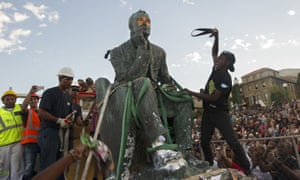
When the statue was installed in the pre-apartheid era, white rule couldn’t be taken for granted – not yet. The suffering of its black residents needed to be naturalised first, and to that end the monument cast Rhodes’s life’s work as a noble struggle, with his supposed civilisational achievements implicitly justifying his policies and the pain they caused. If black Africans were admitted into this anxious reality, it was so their suffering could be diminished and finally negated. They were the obstacle Rhodes surmounted. In place of their suffering we got, obscenely, his suffering.
The statue finally came down a few weeks after the Rhodes Must Fall protests began. It had stood for more than 80 years, including through two decades of majority black rule under the African National Congress (ANC), the party of Nelson Mandela. The protests and the removal of the statue took the South African establishment by surprise, including those, such as the then president, Jacob Zuma, and the archbishop Njongonkulu Ndungane, who a generation earlier had helped end apartheid.

The blindness of the everyday
There was a time not long ago (though it feels like forever) when a kind of blindness was possible as you moved through your city – any city. You could step out of your front door and cross street after street without giving much thought to the former colonies and forgotten diplomats they memorialised; go to school or work in a building named for a famous statesman without doing a moral accounting of his achievements; eat your lunch beneath the statue of another long-ago luminary renowned for his charity without wondering about the provenance of his wealth; stop on your way home to take in a view of the city at night without imagining what, or who, was there before. To never wonder, never imagine: this was possible if your skin was a certain colour.
This is the blindness of the everyday. We grow used to the spaces we inhabit. We stop seeing them. And we grow used to the ideas around us until we can’t see them either. Not long ago it was possible to believe the past was irrelevant – that history had no purchase on the postcolonial, post-cold war, post-everything present. With the horrors of the 20th century behind us, the free market would deliver us into a future where democracy and prosperity were available to all. (Again, this was easier to believe if your skin was a certain colour, if you belonged to a certain class, if you had a certain set of experiences.)
Little by little, that narrative began to fray. The growth and exuberance of the 1990s set the tone for a decade of reckless military adventurism, financial deregulation and economic globalisation, which in turn gave us the disastrous wars in Iraq and Syria, a market crash, multiple refugee crises and massive, rising inequality. At some point along the way, around the time of Brexit and Donald Trump, the ideas we took for granted lost their explanatory power. All around us the historical forces that have always shaped our lives have become visible. The urban monuments we barely noticed have become the centre of protest movements around the world.
As the Cape Town protests spread across South Africa, students at Oxford University in England launched their own version of Rhodes Must Fall: they marched on a statue of Rhodes at Oriel College, demanding it be torn down and that the university curriculum be changed to reflect the diversity of thought beyond the western canon.
In Berlin, social justice groups launched a campaign to rename the African Quarter because of its connection with Germany’s genocidal colonial reign in the early 20th century. The protests have challenged Germany’s self-image as a bastion of tolerance, coming as they have while the country struggles to integrate hundreds of thousands of refugees from the Middle East.
Across the US, Confederate monuments have become the target of protests, most spectacularly in Charlottesville, where anti-racism activists clashed with white supremacists last August over a statue of Confederate army commander Robert E Lee. One woman who was peacefully protesting died and many people were injured. Trump defended the torch-wielding far-right extremists as “very fine people”.
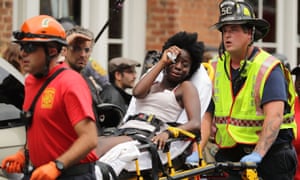
The fury of the counterprotests in Charlottesville and in other cities show how high the stakes in the so-called statue wars are, and how difficult removing the symbols of slavery and colonialism will be. But the protests continue to gain momentum. In the past month, protesters toppled the “Silent Sam” Confederate statue at the University of North Carolina and defaced another monument in Virginia. The city of San Francisco quietly removed a 19th-century statue that celebrated the founding of California – and the humiliation of Native American peoples. Austin, Texas, is supposedly mulling a name change because of its namesake’s association with slavery.
In Canada, the country’s founding prime minister, Sir John A MacDonald, has become the focus of opposition for his role in the cultural genocide of indigenous peoples. The city of Victoria recently announced it would remove his likeness from outside city hall, and MacDonald statues in Montreal and Regina were defaced as pressure mounted to recast his legacy.
From New York to Bristol to Sydney to Bulawayo, no monument is apparently safe.
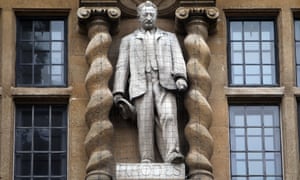
‘Fake news before there was fake news’
In a recent essay for the Guardian on the Oxford protests, the novelist Amit Chaudhuri wonders: “When is it possible to ignore or laugh at statues or symbols, and when does it become hard to do so?” Chaudhuri remembers visiting Oriel College as a student in the early 1990s and finding “its old-fogey students with monarchist enthusiasms, its conservatism … uncharming but weirdly funny”. During the visit he caught a glimpse of Enoch Powell, the former MP whose race-baiting “Rivers of Blood” speech a generation earlier was “synonymous with a dark moment in British history”, and barely flinched. Chaudhuri didn’t even notice the Rhodes statue that would become so controversial. Looking back, he marvels at how irrelevant any reminders of the colonial era felt, and how he shrugged them off so easily.
Our relationship to a statue, or a building, or a sign is always changing. Often the change is so gradual, happening over decades and generations, that the monument – the version of reality it embodies – simply recedes into the background. Of its time: this is the explanation we reach for as we shrug and walk past, if we’ve bothered to look at all. We make the assumption that the past is past, that those ideas and values no longer have the power to threaten or harm, or never did.
The reality is more complicated. For one thing, this is what monuments do: they normalise the past, for better or worse. They make injustices easier to defend and, more insidiously, harder to see. For another, it’s the people most likely to defend those injustices who ultimately decide what is or isn’t threatening, not the people who have been most affected. Only the dominance of the settler majorities in the US, Canada and Australia, for example, can explain their indifference to the statues of Theodore Roosevelt, John A MacDonald, and Captain James Cook that for many indigenous peoples have long represented genocide.
But as the past resonates in unexpected ways as social and economic conditions change, so a monument’s power ebbs and flows. Its semiotics are always volatile. What the Oxford Rhodes represents to students of colour and their allies right now might be closer to what it represented to their counterparts in the 1960s, when the lived experience of colonialism was fresh, than either would be to Chaudhuri’s cohort in the early 1990s, when – as Chaudhuri points out – multiculturalism was ascendant in Britain and their place in an equal, just society felt increasingly secure.

The hated Rhodes statue in Cape Town was relatively uncontroversial in the 1990s. It stood for more than two decades after apartheid, as did (and do) many other white supremacist monuments across South Africa. With Mandela’s election and the transition to black majority rule, victory seemed total: the future was too bright for the past to matter very much.
The country embarked on a forward-looking restorative justice process whereby the perpetrators of apartheid were forgiven so South Africans could move on with the job of building a free and equal society. School curriculums were updated to play down the more painful aspects of the country’s past and many black parents chose not to burden their children, the “Born Frees”, with the history they had lived through and which had been so psychologically devastating. There was power in forgiveness, and in that moment of great optimism it was suddenly possible to regard the figure of Rhodes and feel pity or disgust rather than fear or anger. The statue now contemplated a city whose future, in spite of his life’s work, belonged to all South Africans. Contemporary South Africa was a living, breathing repudiation of Rhodes’s legacy. What need was there to remove the statue?
For black Americans, the symbols of the Confederacy have always had the power to menace. The many hundreds of monuments built in the century following emancipation speak to the brutal, persistent fact of white supremacy; that nearly all of them have remained standing through the civil rights era and the decades that followed, up to the present day, speaks to the fact that, however enlightened white Americans might think they are, their understanding of racism differs wildly from black Americans’ experience of it.
If you believe that America is more or less equal, and whatever discrimination black people face is a problem with individual racists and not the symptom of a racist system, then you might struggle to appreciate the persistent, malevolent power of a stone likeness of Robert E Lee or Confederate president Jefferson Davis. Even if you dislike Confederate iconography, you might still struggle to grasp how fully the legacies of slavery and Jim Crow continue to circumscribe black lives, how they limit opportunity. If black people have failed to thrive in the post-civil rights era, you might convince yourself they just need to strive harder.
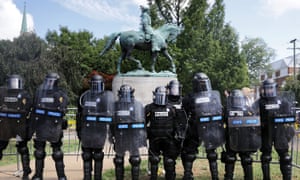
This way of thinking has deep, unbroken historical roots in the “Lost Cause” movement that emerged in the southern states after the civil war – what the historian and public monument expert Madge Dresser calls “fake news before there was fake news”. Led by groups such as the United Confederate Veterans and United Daughters of the Confederacy, the Lost Cause movement sought to recast the defeat of the Confederate army as something tragic and even noble.
In this version of history, the south went to war not to preserve the institution of slavery but to protect states’ rights to self-determination against a federal government determined to impose its secular, cosmopolitan values on southerners’ way of life. What was being defended was tradition, in other words, rather than economic self-interest. Central to this aggressive campaign of historical revisionism were pageants, plays, novels and monuments that portrayed the old south as a proud, Christian culture where men were chivalrous, women virtuous, and black people their spiritual and intellectual wards, in need of correction and uplift.
Hundreds of statues went up across the US between the 1890s and 1950s. Lee, the commander of the losing side, was a favourite avatar of this sentimental and dishonest vision. The Lee mythologised in the Charlottesville monument was brave, honourable and enlightened – if not opposed to slavery, then sensitive to its excesses.
Compare him with the man who emerges from the actual historical record, though, and the revisionism at the heart of the Lost Cause narrative becomes pretty clear: as Dresser noted in a TEDx talk, it was “under [Lee’s] watch that the Confederate army kidnapped free blacks and slaves who had fled north, and forcibly returned them to slavery”. The Lost Cause version of history is at such odds with established fact that when you peel away all the pomp and ceremony, you’re left with kettle logic: the Confederacy didn’t fight to preserve slavery, but even if it did, there were good slave owners, and anyway, those who were enslaved benefited from it. Like colonialism, it was a “civilising” mission.
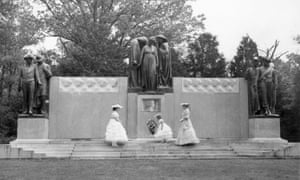
The Lost Cause narrative shaped white Americans’ understanding of slavery and racism. For southern segregationists at the turn of the 20th century, it was a way to reassert their identity within the union and recover a measure of dignity. For northern abolitionists, it was a bargain to be struck for the sake of national unity: let them have their statues and their Confederate flags if it brought them back into the fold. But it did something else too.
Comforting but destructive
These symbols of the Confederacy were allowed to mean very different things to different groups of white people, even as the symbols reaffirmed for both the cherished idea of America as a land of freedom and opportunity. The monumentalisation of figures like Lee allowed segregationists and abolitionists alike to invest themselves in the comforting and ultimately destructive idea that slavery (and, by extension, racism) was a “people” problem – bad slave owners, as the segregationists saw it; all slave owners, as the abolitionists did – and therefore not an “America” problem, not something woven into the fabric of the entire project of American capitalism from the very beginning. As the historian Ibram X Kendi, the author of Stamped from the Beginning: The Definitive History of Racist Ideas in America, has pointed out:
When you make it about ignorance, you’re not making it about power and policy and structures and systems, that the problem centrally is not America’s institutions, is not the American story, is not American capitalism, that the problem is ignorant individuals. So it allows people to deny how fundamental racism has historically been to America.
By shifting the problem of racism on to the individual, white Americans of all political persuasions absolved themselves of their complicity in, and responsibility for dismantling, systemic racism.
This way of seeing things gained a new kind of legitimacy in the 1980s as American politics fell under the spell of the neoliberal economist Friedrich Hayek, who conceived of society itself as a market, and people as individual economic actors rather than, first and foremost, “bearers of grace, or of inalienable rights and duties”. Capitalism could even be the driver of racial progress: the free market would solve the “people problem” of racism because self-interest would lead everyone, eventually, to enlightenment – obviating the need for critical policy solutions. As the writer Pankaj Mishra has noted:
The cruellest trick used by both Republicans and Democrats was the myth that America had resolved the contradiction at the heart of its democracy. For the conviction that African-Americans were walking and running and would soon start flying, enabled by equal opportunity, paved the way for an insidious ideological force: colour-blind universalism.
During the cold war, any serious discussion about the deeper, structural causes of racial inequality was impossible because it required some degree of apostasy – entwined as the problem was with the very roots of American capitalism – and because inequality at home paled next to the threat of Soviet domination. The cold war limited the spectrum of political possibility, not just in the US but around the world. It hijacked the process of decolonisation happening in many of the newly independent nations of Africa, Asia and the Middle East. There was to be no renegotiation of their relationships with the west on something like equal terms. Those relationships were reset instead along cold war faultlines.
In the scramble for ideological supremacy, the Americans and the Soviets traded money and arms for allegiance, intervening in elections and propping up sympathetic strongmen where necessary. The dynamic of patron state and client state obscured the dysfunction these fledgling nations inherited from the colonial regimes that preceded them, perpetuating and even exacerbating their inequality and brutality.
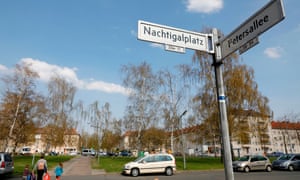
The fall of the Soviet Union in the early 1990s represented more than just a victory of capitalism over communism: it reaffirmed the Enlightenment narrative of progress, so badly tested by the horrors of the 20th century. Western-style liberal democracy was the destination, and free trade and globalisation were the twin engines that would take the world there. Neoliberalism’s time had come.
The problem was that neoliberalism preserved classical liberalism’s blind spots: its pretense to universalism (of the exceedingly white, male landowner variety) and over-idealisation of the market. Never mind the deep inequality that existed between and within nations: a deregulated global market would be the tide that lifted all boats. Applied as a broad, one-size-fits-all solution to the challenges facing impoverished and traumatised post-Soviet and postcolonial nations (as well as increasingly multicultural countries in the west, with complicated histories of their own), neoliberalism couldn’t help but be disastrous for many people.
For a while, though, things looked pretty good. The economies of the west grew rapidly and countries such as China, India and Brazil began to emerge as economic powers in their own right. In many countries the upper and middle classes flourished. Even if your own situation was tenuous, a kind of aspirational fellow-travelling was still possible. From your vantage point on the lower rungs of wealthier countries or the middle rungs of poorer ones, you might watch other people growing richer and think, One day that will be me. The promise of neoliberalism was the promise that the burden of history was being lifted from your shoulders.
And this was true in a sense: the victory of the west over the Soviet Union lifted the threat of global cataclysm that had existed for most of the previous 75 years. But the psychological weight of the cold war and now the euphoria and triumphalism of the neoliberal moment obscured the other forces of history that had been (and still were) bearing down on you all along. All of which paved the way for the hubris of the 21st century’s first decade.
Fast-forward to 2018. The wars in Iraq, Afghanistan and Syria have displaced nearly 20 million people, part of the largest refugee crisis in modern history. The top 1% of people now own half of global wealth, while the bottom 70% account for less than 3%. The past few years have seen the Great Recession, the steady breakdown of international norms, the rise of illiberal democracy and re-entrenchment of authoritarian regimes, and the emergence of rightwing populism in the west, leading to the self-inflicted wounds of Brexit and the Trump presidency. Meanwhile the world faces a new existential crisis: climate change. The impact of decades of unchecked growth is now undeniable, with rising temperatures and quickening cycles of natural disasters that threaten new calamities every day.
Suddenly life feels overdetermined, shaped by forces larger than any individual, community or nation. Larger than the now. In the anxious present, it has become very hard indeed for anyone to ignore or laugh at statues or symbols of the past.
In an article published not long after the Cape Town protests broke out, young activists describe the experiences that led them to Rhodes Must Fall. Chumani Maxwele, the student who started the protests, recalls looking around his neighbourhood and struggling to understand why, nearly two decades after the end of white rule, everyone was still so poor. A student from an upper-middle-class background remembers seeing the mostly white faces and white professors in his classes and wondering why he was the exception. A third student remembers having to discover for herself the works of black thinkers such as Frantz Fanon and Steve Biko because they weren’t taught at school.
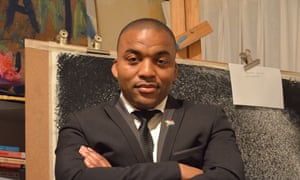
Each was troubled by the feeling that the world around them didn’t make sense, and little by little they began to connect the inequality of the present to the past that Rhodes represented. The South African government’s well-meaning attempt at a clean break with history played a significant role in the alienation of the post-apartheid generation. As the upper-middle-class student says in the story: “Our experience of racism is worse. It’s subliminal. The form of racism that makes you ignorant about your subjugation.”
Those policies alone don’t explain the sudden fury of the protests, though. Even as the ANC had tackled the problem of race with a comprehensive programme of reconciliation, it did not dismantle apartheid’s economic legacy to alleviate the poverty of the many. Instead the government pursued a long-term strategy of austerity and privatisation, which entrenched the highly stratified society in slightly different form: a tiny group of white and now black South Africans at the top, a small black bourgeoisie in the middle, and a massive black underclass. No surprise, then, that for the students who came of age in the post-apartheid era, the Rhodes statue would be flush with menace once again.
The cognitive dissonance the students describe is not unique to Cape Town or South Africa. As the lens through which people view the world comes to feel insufficient, they go looking for deeper explanations and discover the buried continuities between the injustices of the past and the present. For the Oxford protesters, it’s the privatisation of British society and, as Chaudhuri notes, “gradual extinction … of the ideals of multiculturalism” over the past several decades. For Americans, it is extreme inequality, which has made reconciling the idea of America with the grim prospects they face nearly impossible. And so on.
But many other people have arrived at the opposite conclusion: the situation is bad today because we have strayed too far from the way things used to be. The nostalgia of Brexit and Make America Great Again is exactly an appeal to the consoling idea (for some white people) that the moral failures of the past are, in fact, the triumphs we once thought they were.
Statues, buildings and street signs have become flashpoints because they embody the tension between these two worldviews.

Reconciliation
So what should we do with troublesome monuments? Based on the media coverage that the Cape Town and other protests have attracted, you’d be forgiven for thinking that controversial monuments are falling all the time, all over the world. In fact, most – including the statue at the centre of the tragic Charlottesville protests, and the vast majority in the US, Canada, Australia, New Zealand and South Africa – remain untouched.
There are those who would remove the most offensive signs and statues (the so-called antagonistic approach), those who would modify them to reflect contemporary sensibilities (agonism), and those who would leave them alone (conservatism).
Conservatism is clearly the easiest option, and the least tenable one because if the past is not past, and some monuments never totally lose their power to threaten certain groups of people, then they can’t be left to stand unaltered. We have a responsibility to take those threats seriously whether we see them at first glance or not. They are not idle threats: these monuments have not lost their power to normalise the dominance of one group of people over another. At best they seem embarrassing or irrelevant; at worst they help to nourish an aggrieved sense of superiority among what is clearly a growing number of people. The white supremacist rally in Charlottesville is only one of the more obvious examples of their everyday toxic effect.
On the other hand, what is actually lost when a statue of Rhodes or Lee falls? Virtually all western cities are monuments to colonialism. Either they were superimposed on earlier indigenous settlements (New York), founded to support the trade in slaves and natural resources (Cape Town), or substantially built with capital extracted from the colonies (pretty much any major European city). Removing a few of the most egregious statues will not, as some people fear, erase the histories of these places, nor diminish the cultural heritage their residents are, for better and worse, heir to.
Dresser makes the case that something else is lost: an opportunity. “As a historian, I love the idea that you have all these different statues from different eras that represent changing value systems – a palimpsest that enriches the urban landscape,” she tells me. “But then I’m not a black student in Oxford feeling that the white imagination is excluding me from belonging, which is important. So do we eviscerate this historical building? If we get rid of problematic statues, we foreclose the discussions we can have about those statues, which is important to the evolution of our shared identity. But if we keep them, what are we saying to these students?”
Oxford University has tried to stake out the middle ground, announcing that the Rhodes statue at Oriel College will stay, with modifications that “draw attention to this history [and] do justice to the complexity of the debate”. Proposals include building a second version of the statue that could be defaced with graffiti. This idea of agonism is appealing: it seems both creative and reasonable. Cities such as Asunción, Hamburg and Odessa have all invited artists to rework and recontextualise statues with troubling legacies, with interesting and even powerful results. In Asunción, a hated statue of the former dictator Alfredo Stroessner was crushed and the pieces reassembled into a much-praised monument to those who resisted his regime.
Amin Husain, one of the organisers of recent protests at the American Museum of Natural History in New York that saw a statue of Theodore Roosevelt splattered with red paint, argues that agonism doesn’t go far enough. The problem with keeping but modifying statues, he says, “is that it’s still the dominant group that sets the terms of the debate. Shouldn’t affected communities have a say? If you want to learn from it, but you don’t want to perpetuate that mythology that is doing harm every day, you can put it in a museum or a statue garden.”
Even if agonism can work as a dialogue between cities and affected communities, it is limited in what it can do. It remains centred on the sins of the coloniser, in relation to which the colonised are thus always secondary. We can modify statues to recognise historical truths, and to perform a kind of apology, but that’s as far as agonism goes. Given the now impossible-to-ignore continuity between the misdeeds of the past and the conditions people face in the present, this feels insufficient.
No single solution – leave up, tear down, modify – is equal to the problem, because each is zero-sum when applied case by case. A thoroughgoing approach that considers each case in relation to the larger urban landscape might be needed to tackle such complexity. Modify some monuments to reflect those histories, whether by adding interpretive signs or re-engineering them. Tear down others to make space for new ones that represent affected communities on their own terms, not just in relation to their victimisation. Representation is critical.
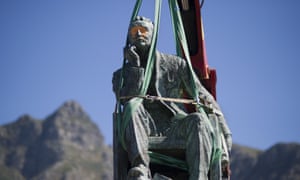
Vancouver, where I live, offers an unlikely example of what that approach might look like. Today the city is known for its easygoing charm and expensive real estate. 150 years ago, and for millennia before that, the area was the hunting and fishing grounds of the Musqueam, Squamish and Tsleil-Waututh peoples. Their settlements dotted the shores of the Burrard inlet and Fraser and Capilano rivers. The arrival of Europeans and founding of Vancouver precipitated their almost total erasure over the next 150 years.
In 2014, Vancouver declared itself a “city of reconciliation”, formally recognising its occupation of the unceded territories and embarking with local First Nations governments on a longterm plan to decolonise and indigenise the city. To begin with, some streets, parks, schools and landmarks will be renamed, including Siwash Rock, a well-known sea stack near Stanley Park whose name (derived from the French word for “savage”) is seen as an offensive slur against indigenous people.
The new names will be specific to the group whose territory the landmark or sign is on – for example, Sir William Macdonald elementary school, which sits on Musqueam territory, recently became Xpey’ elementary school, meaning “cedar” in the local hən̓q̓əmin̓əm̓ (Halkomelem) language. The University of British Columbia, which also sits on Musqueam territory, has replaced all of the street signs on campus with bilingual street English-hən̓q̓əmin̓əm̓ ones. The sites of historical villages will be reinscribed with signs and interpretive displays, and other artistic interventions. “The point is to make sure Musqueam, Squamish and Tsleil-Waututh are reflected and visible everywhere in Vancouver,” Ginger Gosnell-Myers, the city’s aboriginal relations manager, tells me.
Renaming and monumentalisation are only the most obvious aspect of the process. “Colonial structures permeate every part of the city, from the place names to the architecture and the use of space, even the way city departments are organised,” Gosnell-Myers says. “So for reconciliation to actually work, the plan needed to be comprehensive, too.” Inspired by a similar exercise in New Zealand, the partners have together created a set of indigenous design principles that will inform the design of all future public space in Vancouver – including sightlines and building materials, the ways structures relate to the natural environment, and how they are used. There will be greater emphasis on communal, intergenerational public spaces, for example, because in the local indigenous cultures, all buildings are meant to be used by all people.
Everyone agrees that reconciliation can’t just be about the past; it must be forward-looking. “When we say we want to indigenise the city, the first thing somebody’s going to say is that we need to put a longhouse [a traditional dwelling] here,” Gosnell-Myers says. “But what does a city with contemporary indigenous culture look like? A mixture of the wood and the glass and the metal from a design standpoint?”
The challenge is that Vancouver does not have any Musqueam, Squamish or Tsleil-Waututh architects or urban designers, because local indigenous people have for so long been shut out of opportunities for education and professional advancement. “We could have done the easy thing and hired indigenous architects from other parts of Canada,” she said, “but it’s not true to who we are as a city of reconciliation.” Part of the process is training local indigenous designers and planners who can translate and synthesise their cultures into contemporary urban forms. In the meantime, the city has begun the work of hiring indigenous professionals across all departments, from engineering to finance, so that every civic decision takes indigenous perspectives into account.
Obviously, not every city would benefit from the same solutions as Vancouver. Even the success of the City of Reconciliation project is not assured. For one thing, Vancouver must solve its longstanding affordability crisis – the result of decades of policies geared toward globalising the local real estate market – which affects indigenous and other vulnerable groups disproportionately. If indigenous people can’t afford to live in the city, then “reinscribing” their presence will amount to a branding exercise. Such a risk raises the much bigger question of whether decolonisation is even possible within capitalism as it is currently constituted.
But in spirit at least, the project shows how cities might begin to rethink their relationship to the past. Public space is one of the few truly populist mediums we still have, especially as people retreat in their private lives to the echo chambers of social media. If, as Dresser argues, the right tends to be “more effective at mobilising public opinion because they focus less on abstract, universal values and more on the particulars of place, historic and family traditions … on people’s emotions and their need for belonging,” then here is a way to engage people with the facts of historical injustice while also appealing to their sense of belonging.
For minority groups, this means seeing themselves represented in ways that recognise their historical marginalisation but also go well beyond that, making their contemporary perspectives and experiences a central part of civic culture. For everyone else, this means relating to these perspectives and experiences as we move through the city every day, in ways that include but aren’t limited to that painful history. It is in spaces where everyone belongs that justice and equality begins.
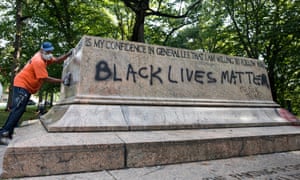
A new consensus on reality?
We live in uncertain times. As neoliberalism stutters and falters, political space is opening up. For the xenophobia and illiberalism of Trump and his imitators, yes, but also for the emancipatory politics of Black Lives Matter, #MeToo, Idle No More, Rhodes Must Fall and monument protests around the world. They are as bold as any in recent memory. Even if they don’t amount to a single movement, we are seeing a shift in thinking in the west; a repudiation not just of the neoliberal status quo but of the deeper historical structures that support it.
It’s an open question whether, in this era of fake news and hyperpartisan politics, we can even hope for something like a new consensus on reality: a set of facts, a way of seeing the world to replace the neoliberal narrative we are leaving behind. That won’t stop people from trying to establish one, in good faith and bad, and without resistance it is the powerful who will set the terms. Which is what gives the protests in Cape Town, Charlottesville, Berlin, Oxford and beyond such urgency.
Facts matter, and the protests are, at bottom, about facts – the historical truth of colonialism, slavery and patriarchy, and the contemporary truth of the people they still marginalise. Without facts and without protest, the best we can hope for is that these systems and their legacies will continue to exert their insidious effect. At worst, they will be fully rehabilitated and weaponised. We are seeing this already in the resurgence of rightwing populism all over the world.
Until it happened, no one would have imagined that the spontaneous protest of a South African student would inspire long-overdue discussions about structural racism, not just in South Africa but in Britain and Canada and Germany, too. Nor that cities like Berlin, Toronto, Baltimore and New Orleans would begin quietly removing racist monuments of their own accord, or that Auckland and Vancouver would commit wholeheartedly to indigenisation. All these things were impossible to imagine until they happened, just as the injustices of the past are impossible to see until you see them everywhere. Minds and eyes are opening – come what may.
- This article was amended on 27 September 2018 to correct the name of former Paraguayan dictator Alfredo Stroessner
Follow Guardian Cities on Twitter, Facebook and Instagram to join the discussion, and explore our archive here
News is under threat …
… just when we need it the most. Millions of readers around the world are flocking to the Guardian in search of honest, authoritative, fact-based reporting that can help them understand the biggest challenge we have faced in our lifetime. But at this crucial moment, news organisations are facing a cruel financial double blow: with fewer people able to leave their homes, and fewer news vendors in operation, we’re seeing a reduction in newspaper sales across the UK. Advertising revenue continues to fall steeply meanwhile as businesses feel the pinch. We need you to help fill the gap.
We believe every one of us deserves equal access to vital public service journalism. So, unlike many others, we made a different choice: to keep Guardian journalism open for all, regardless of where they live or what they can afford to pay. This would not be possible without financial contributions from those who can afford to pay, who now support our work from 180 countries around the world.
Reader financial support has meant we can keep investigating, disentangling and interrogating. It has protected our independence, which has never been so critical. We are so grateful.
We need your support so we can keep delivering quality journalism that’s open and independent. And that is here for the long term. Every reader contribution, however big or small, is so valuable. Support The Guardian from as little as $1 – and it only takes a minute. Thank you.

